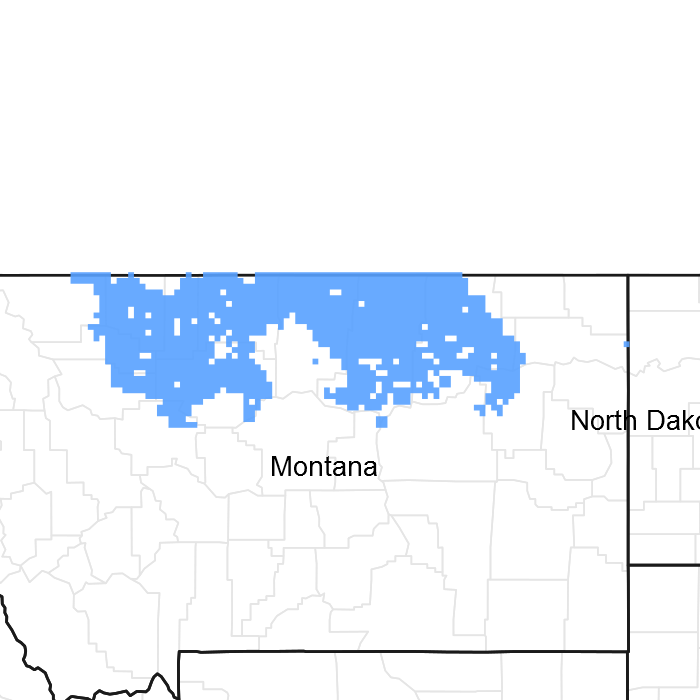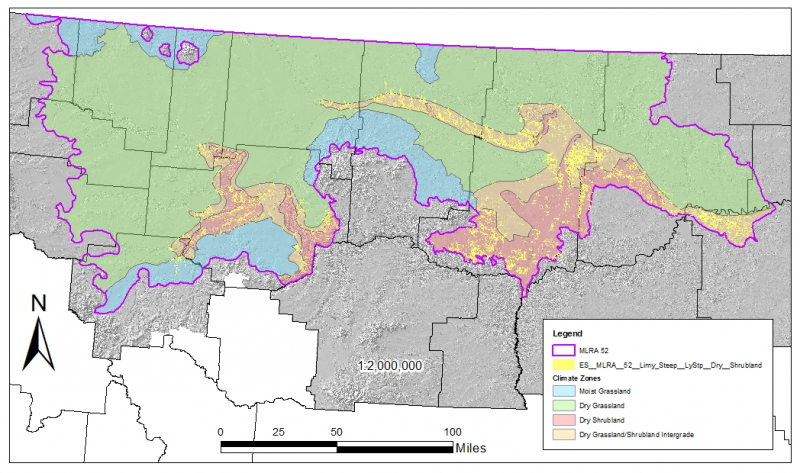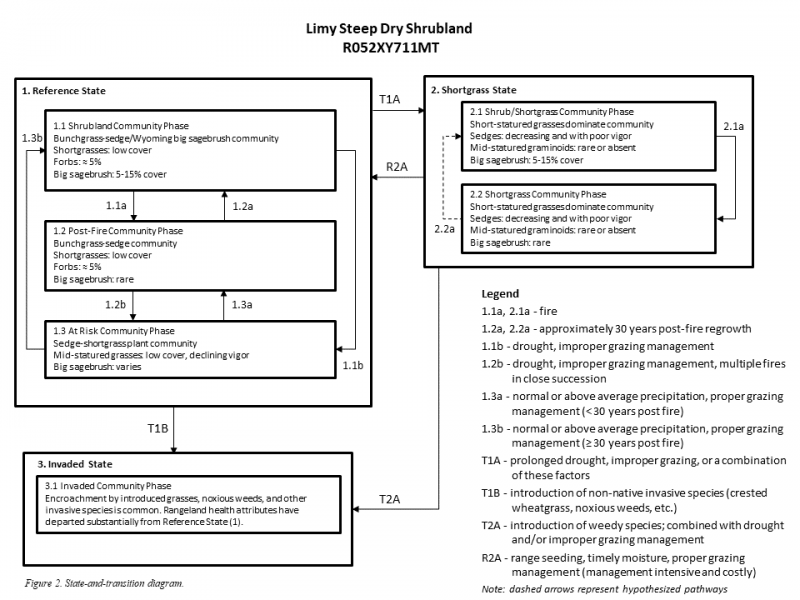
Natural Resources
Conservation Service
Ecological site R052XY711MT
Limy-Steep (Lystp) Dry Shrubland
Last updated: 7/03/2019
Accessed: 12/21/2025
General information
Provisional. A provisional ecological site description has undergone quality control and quality assurance review. It contains a working state and transition model and enough information to identify the ecological site.

Figure 1. Mapped extent
Areas shown in blue indicate the maximum mapped extent of this ecological site. Other ecological sites likely occur within the highlighted areas. It is also possible for this ecological site to occur outside of highlighted areas if detailed soil survey has not been completed or recently updated.
MLRA notes
Major Land Resource Area (MLRA): 052X–Brown Glaciated Plains
The Brown Glaciated Plains, MLRA 52, is an expansive, agriculturally and ecologically significant area. It consists of approximately 14.5 million acres and stretches across 350 miles from east to west, encompassing portions of 15 counties in north-central Montana. This region represents the southwestern limit of the Laurentide Ice Sheet and is considered to be the driest and westernmost area within the vast network of glacially derived prairie pothole landforms of the northern Great Plains. Elevation ranges from 2,000 feet (610 meters) to 4,600 feet (1,400 meters).
Soils are primarily Mollisols, but Entisols, Inceptisols, Alfisols, and Vertisols are also common. Till from continental glaciation is the predominant parent material, but alluvium and bedrock are also common. Till deposits are typically less than 50 feet thick, and in some areas glacially deformed bedrock occurs at or near the soil surface (Soller, 2001). Underlying sedimentary bedrock largely consisting of Cretaceous shale, sandstone, and mudstone (Vuke et al., 2007) is commonly exposed on hillslopes, particularly along drainageways. Significant alluvial deposits occur along glacial outwash channels and major drainages, including portions of the Missouri, Teton, Marias, Milk, and Frenchman Rivers. Large glacial lakes, particularly in the western half of the MLRA, deposited clayey and silty lacustrine sediments (Fullerton et al., 2013).
Much of the western portion of this MLRA was glaciated towards the end of the Wisconsin age, with the maximum glacial extent occurring approximately 20,000 years ago (Fullerton et al., 2004). The result is a geologically young landscape that is predominantly a level till plain interspersed with lake plains and dominated by soils in the Mollisol and Vertisol orders. These soils are very productive and generally are well suited to dryland farming. Much of this area is aridic-ustic. Crop-fallow dryland wheat farming is the predominant land use. Areas of rangeland typically are on steep hillslopes along drainages.
The rangeland, much of which is native mixedgrass prairie, increases in abundance in the eastern half of the MLRA. The Wisconsin-age till in the north-central part of this area typically formed large disintegration moraines with steep slopes and numerous poorly drained potholes. A large portion of Wisconsin-age till occurring on the type of the level terrain that would typically be optimal for farming has large amounts of less-suitable sodium-affected Natrustalfs. Significant portions of Blaine, Phillips, and Valley Counties were glaciated approximately 150,000 years ago during the Illinoisan age. Due to erosion and dissection of the landscape, many of these areas have steeper slopes and more exposed bedrock than areas glaciated during the Wisconsin age (Fullerton and Colton, 1986).
While much of the rangeland in the aridic-ustic portion of MLRA 52 is classified as belonging to the “dry grassland” climatic zone, sites in portions of southern MLRA 52 may belong to the “dry shrubland” climatic zone. The dry shrubland zone represents the northernmost extent of the big sagebrush (Artemisia tridentata) steppe on the Great Plains. Because similar soils occur in both southern and northern portions of the MLRA, it is currently hypothesized that climate is the primary driving factor affecting big sagebrush distribution in this area. However, the precise factors are not yet fully understood.
Sizeable tracts of largely unbroken rangeland in the eastern half of the MLRA and adjacent southern Saskatchewan are home to the Northern Montana population of greater sage grouse (Centrocercus urophasianus), and large portions of this area are considered to be a Priority Area for Conservation (PAC) by the U.S. Fish and Wildlife Service (U.S. Fish and Wildlife Service, 2013). This population is unique among sage grouse populations in the fact that many individuals overwinter in the big sagebrush steppe (dry shrubland) in the southern portion of the MLRA and then migrate to the northern portion of the MLRA, which lacks big sagebrush (dry grassland), to live the rest of the year (Smith, 2013).
Areas of the till plain near the Bearpaw and Highwood Mountains as well as the Sweetgrass Hills and Rocky Mountain foothills are at higher elevations, receive higher amounts of precipitation, and have a typic-ustic moisture regime. These areas have significantly more rangeland production than the drier aridic-ustic portions of the MLRA and have enough moisture to produce crops annually rather than just bi-annually, as in the drier areas. Ecological sites in this higher precipitation area are classified as the moist grassland climatic zone.
Classification relationships
NRCS Soil Geography Hierarchy
• Land Resource Region: Northern Great Plains
• Major Land Resource Area (MLRA): 052 Brown Glaciated Plains
• Climate Zone: Dry Shrubland
National Hierarchical Framework of Ecological Units (Cleland et al., 1997; McNab et al., 2007)
• Domain: Dry
• Division: Temperate Steppe
• Province: Great Plains-Palouse Dry Steppe Province 331
• Section: Northwestern Glaciated Plains 331D
• Subsection: Montana Glaciated Plains 331Dh
• Landtype Association/Landtype Phase: N/A
National Vegetation Classification Standard (Federal Geographic Data Committee, 2008)
• Class: Xeromorphic Woodland, Scrub and Herb Vegetation Class (3)
• Subclass: Cool Semi-Desert Scrub and Grassland Subclass (3.B)
• Formation: Cool Semi-Desert Scrub and Grassland Formation (3.B.1)
• Division: Cool Semi-Desert Scrub and Grassland Division (3.B.1.Ne)
• Macrogroup: Artemisia tridentata - Artemisia tripartita ssp. tripartita - Purshia tridentata Steppe and Shrubland Macrogroup (3.B.1.Ne.3)
• Group: Artemisia tridentata ssp. wyomingensis - Artemisia tridentata ssp. tridentata Steppe and Shrubland Group (3.B.1.Ne.3.a)
• Alliance: Artemisia tridentata ssp. wyomingensis Dry Steppe and Shrubland Alliance
• Association: Artemisia tridentata ssp. wyomingensis / Carex filifolia Shrubland
EPA Ecoregions
• Level 1: Great Plains (9)
• Level 2: West-Central Semi-Arid Prairies (9.3)
• Level 3: Northwestern Glaciated Plains (42)
• Level 4: North-central Brown Glaciated Plains (42o) and Glaciated Northern Grasslands (42j)
Ecological site concept
This provisional ecological site occurs in the Dry Shrubland climatic zone of MLRA 52. Figure 1 illustrates the distribution of this ecological site based on current data. This map is approximate, is not intended to be definitive, and may be subject to change. Onsite evaluations are necessary, particularly in boundary or intergrade areas where ecological sites from multiple climate zones may overlap. Limy Steep Dry Shrubland is an extensive ecological site occurring on most landscapes in MLRA 52. It occurs on hillslopes, till plains, and bluffs where slopes are 15 percent or greater. This site is typically on convex backslopes or shoulders.
The distinguishing characteristics of this site are moderately steep to very steep slopes and a relatively young, undeveloped soil profile, which is evidenced by increased calcium carbonate (lime) concentrations in the upper 5 inches, and weak structure. Soils are typically deep to very deep (more than 40 inches) and derived from glacial till. Soil surface textures are typically in the fine-loamy textural family, meaning they contain 18 to 35 percent clay. Calcium carbonate (CaCO3) equivalent is 5 percent or more (as evidenced by strong or violet effervescence) in the upper 5 inches with CaCO3 concentration increasing with depth. Characteristic vegetation is plains muhly (Muhlenbergia cuspidata), needle and thread (Hesperostipa comata), threadleaf sedge (Carex filifolia), and Wyoming big sagebrush (Artemisia tridentata subsp. wyomingensis).
Associated sites
| R052XY712MT |
Loamy (Lo) Dry Shrubland This site occurs adjacent to or upslope from the Limy Steep Dry Shrubland ecological site. It generally occurs on summits or footslopes with slopes where the slope is less than 15 percent and the slope shape is linear or concave. |
|---|---|
| R052XY710MT |
Limy (Ly) Dry Shrubland This site occurs on slopes less than 15 percent adjacent to or upslope from the Limy Steep Dry Shrubland ecological site. It is generally on shoulders or crests with a convex slope shape; whereas, the Limy Steep Dry Shrubland ecological site is in backslope positions. |
| R052XY714MT |
Loamy-Steep (Lostp) Dry Shrubland This site occurs on slopes 15 percent or greater adjacent to the Limy Steep Dry Shrubland ecological site. It is generally in backslope positions with a linear or concave slope shape; whereas, Limy Steep Dry Shrubland ecological site is in backslope positions with a convex slope shape. |
Similar sites
| R052XY029MT |
Limy-Steep (Lystp) Dry Grassland This site differs from Limy Steep Dry Shrubland ecological site in that it has slightly cooler annual temperatures and supports silver sagebrush rather than big sagebrush. |
|---|---|
| R052XY714MT |
Loamy-Steep (Lostp) Dry Shrubland This site differs from the Limy Steep Dry Shrubland ecological site in that soils contain less than 5 percent calcium carbonate in the upper 5 inches (as evidenced by lack of effervescence). |
| R052XY710MT |
Limy (Ly) Dry Shrubland This site differs from the Limy Steep Dry Shrubland ecological site in that slopes are less than 15 percent. |
Table 1. Dominant plant species
| Tree |
Not specified |
|---|---|
| Shrub |
Not specified |
| Herbaceous |
Not specified |
Click on box and path labels to scroll to the respective text.

